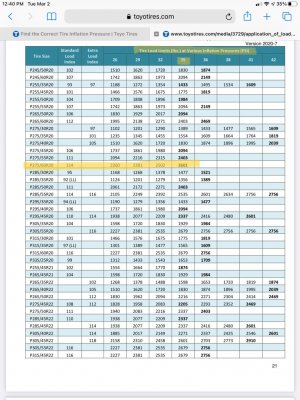corneileous
Senior Member
- Joined
- Sep 6, 2016
- Posts
- 6,852
- Reaction score
- 3,918
- Location
- Podunkyville, OK
- Ram Year
- 2018 Ram 1500 Limited 4X4
- Engine
- Hemi 5.7
@Cornballnelius
So, tell me something.... why do you believe in this so much? What does this tell you that it’s obviously and apparently not telling me?
Answer to the first question is simple, its a U.S. federal vehicle safety regulation. These are issued by the NHTSA. The NHTSA falls under the U.S. Department of Transportation.
Second question, I don’t know sir. The material is written in plain English, so I have no idea why you think it’s telling me something different than what it tells you.
Do you really believe that this tire won’t support what is says stamped on the sidewall if it’s all the sudden put on a truck? How?
I do beleive the tire will support the weight stampted on the tire, never disputed that. I simply stated when that particular tire is used in a light truck application FMVSS REGULATIONS set forth by the NHTSA states their load carrying capacity is de-rated by a factor of 1.1 which in the case of the stock Goodyear’s equates to 2,365 lbs. I didn’t make this up, the U.S. D.O.T. did.
And no, I’m not aiming to stir up conflict either but I am highly intrigued to how someone can believe into this.
Again, I’m citing Federal guidelines so I fail to understand why you are so intrigued by the fact I believe this. What is it about federal regulation that you are so adverse to? Just because you and every tire guy you’ve spoken with in your area have never heard of these regulations doesn’t mean they don’t exist and are not pertinent.
I mean what, since you haven’t really addressed anything I’ve said in response to you, are you trying to confuse this with actual load ratings on any given truck? Is that why you’re saying this tire in particular will only hold 2,365 pounds at 39 psi, nothing more, nothing less? What vehicle could I trust with the markings on the tire? Is there any vehicle that this tire will safely support 2,601 pounds at 44psi?
I have directly addressed and responded to your question with written documentation. I am not confused about load ratings on any given truck (I am talking specifically about the tire load ratings). In regards to what vehicle you can trust with the markings on the tire, it depends on the vehicle and the tire. THATS WHY THE LOAD INFLATION TABLES EXISTS. To answer the last question in this section, any car, minivan, or less than full size SUV.
Not going to comment on the pic you sent other than thank you. My buddy Norman who happens to be the manager at a Discount Tire in my area will be relieved to know you’ve confirmed the Discount Tire stores up in your area look just like the ones here in Atlanta.
There are about 7 or 8 of these stores in about a 150 mile radius of me so I guess tomorrow I can call each one of them but I’m almost one hundred percent certain I’ll get the same answer so if I do, are you gonna condemn each place? What about when I first statedtalking to you and said that three well known tire brands told me the same thing “my local tire guy” told me? No comment towards that?
I didn’t tell you to condemn any of them, I suggested you find another tire guy (that may very well be someone else at the same store who’s a little more informed). To your statement about my “no comment on that”: I replied in my previous post citing the load inflation tables from Toyo Tires. They are a very well known national brand so I again question who you’re talking to or getting replies from. I seriously doubt Toyo is held to different regulations than the “three well known tire brands” you referenced above. Toyo is clearly aware of these regulations...........
Look, I’m not trying to be an *******. I’m just trying to understand why you believe into this or if you’re actually sure what it actually means that you’re believing into.
I’m not trying to be an azzhole either. My belief in these regulations is just the same as regulations set forth by the I.R.S. or the D.O.T. I am being very specific and citing federal regulations that are published. I am 100% sure I understand and comprehend what I’ve read.
Maybe some other fellow members will chime in here, this topic has been discussed more than a few times on this forum and more than a few members other than me have referenced the very same information.
So now I’m a cornball because none of this makes sense to me?...wow....lol. Resorting to name calling, huh? Ya really think that’s gonna get you anywhere?
But I don’t know, man. I’ve made my phone calls looking for better explanations but nobody ‘cept this web forum and the links that a few of its members post is the only thing that can tell me anything about this derating by 1.1 stuff but whatever. I realize my truck can only be weighted so much and just because I can air my tires to beyond 39 psi, I’ve never not ever known that that will magically “increase” what my truck can do. The only reason why I said I’d be airing them to their max if I was pulling heavy because max pressure means max capacity- for the tire.
But sorry about the extreme facetiousness with that photo but uh, again, you said it, not me. I don’t consider Discount Tire as just a mediocre tire shop like you hinted at.
Sent from my iPhone using Tapatalk


